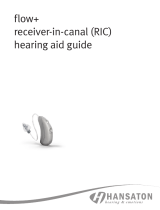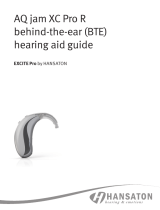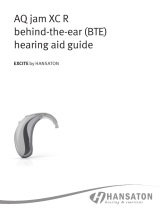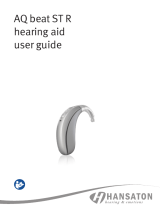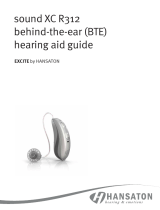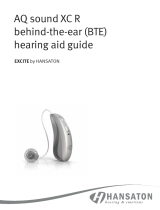Page is loading ...

jam XC Pro R312 M
behind-the-ear (BTE)
hearing aid guide

Thank you
Thank you for choosing these hearing aids.
Your hearing aids
Hearing care professional: ____________________
___________________________________________
Telephone: _________________________________
Model: ____________________________________
Serial number: ______________________________
Warranty: __________________________________
Program 1 is for: ____________________________
Program 2 is for: ____________________________
Program 3 is for: ____________________________
Program 4 is for: ____________________________
Date of purchase:____________________________
This user guide applies to the following models:
Year of introduction:
jam XC Pro 9-R312 M
jam XC Pro 7-R312 M
jam XC Pro 5-R312 M
jam XC Pro 3-R312 M

Your hearing aids at a glance ..................................................... 2
Warnings .................................................................................... 4
Tinnitus masker ........................................................................15
Turning your hearingaids onando ....................................... 18
Battery information ...................................................................19
Putting your hearing aids on your ears..................................... 22
Operating instructions ............................................................. 24
Pairing your mobile phone with your hearing aids ............ 27
Phone calls with a mobile phone ...................................... 29
Using your mobile phone with your hearing aids .............. 30
Adjusting volume balance between mobile phone
calls and your environment ............................................... 32
TV Connector ..................................................................... 33
Tinnitus masker ........................................................................ 34
Flight mode .............................................................................. 35
Connectivity overview .............................................................. 37
Assistive listening devices ....................................................... 38
Caring for your hearing aids ..................................................... 39
Cleaning your hearing aids ....................................................... 40
Accessories .............................................................................. 44
Troubleshooting guide ............................................................. 46
Warning to hearing aid dispensers (tocomplywith the
U.S. Food and Drug Administration (FDA) regulations) ............51
Information and explanation of symbols ................................. 53
Compliance information ........................................................... 56
Your feedback .......................................................................... 59
Additional notes ....................................................................... 60
Table of contents
Quick reference
2 beeps every
30 minutes
Low battery warning Battery size
312
On/O
Multi-function button
O
On Battery symbol
Changing batteries

2 3
Your hearing aids at a glance
1 Earhook - your custom made earmold attaches to
your hearing aids using the earhook
2 Microphone - sound enters your hearing aids
through the microphones.
3 Multi-function button - switches between
listening programs, changes the volume level,
and accepts or rejects mobile phone calls
depending on your customized tting
4 Battery door (on & o) - close the door to turn on
your hearing aids, open the door all the way to
turn o your hearing aid or to change the battery
5 Tubing - part of the earmold that attaches it to
the earhook
6 Earmold - allows the sound to pass from the
hearing aids to the ear and holds the hearing aids
in place
7 Slim tube - sound travels down the slim tube to
the ear canal
8 Dome - holds the slim tube in place in your ear canal
jam XC Pro R M BTE hearing aid
2
3
2
4
1
5
6
2
3
2
4
7
8

4 5
Warnings
Changes or modications to the hearing
aids that are not explicitly approved by
the manufacturer are not permitted. Such
changes may damage your ear or the hearing
aids.
The intended use of hearing aids is to
amplify and transmit sound to the ears and
hereby compensate for impaired hearing.
The hearing aids (specially programmed for
each hearing loss) must only be used by the
intended person. They should not be used
by any other person as they could damage
hearing.
Hearing aids should only be used as
directed by your physician or hearing care
professional.
Hearing aids will not restore normal
hearing and will not prevent or improve a
hearing impairment resulting from organic
conditions.
Do not use your hearing aids in explosion
hazard areas.
Allergic reactions to hearing aids are
unlikely. However, if you experience itching,
redness, soreness, inflammation or a burning
sensation in or around your ears, inform your
hearing care professional and contact your
physician.
In the unlikely case that any parts remain in
the ear canals aer the removal of the hearing
aids, contact a physician immediately.
Hearing programs in the directional
microphone mode reduce background noises.
Please be aware that warning signals or
noises coming from behind, e. g. cars, are
partially or entirely suppressed.
These hearing aids are not for children
below 36 months. The usage of this device
by children and individuals with cognitive
impairment should be supervised at all times
to ensure their safety. The hearing aids are
small devices and contain small parts.

6 7
Do not leave children and individuals with
cognitive impairment unsupervised with
these hearing aids. If swallowed, consult
a physician or hospital immediately as
the hearing aids or their parts can cause
choking.
Do not make a wire connection from your
hearing aids to any external audio sources
like radio etc. That could cause injuries on
your body (electric shock).
The following is only applicable for persons
with active implantable medical devices
(i.e. pacemakers, debrillators, etc.):
- Keep the wireless hearing aids at least 15
cm (6 inches) away from the active implant.
- If you experience any interference, do not
use the wireless hearing aids and contact
the manufacturer of the active implant.
Please note that interference can also
be caused by power lines, electrostatic
discharge, airport metal detectors etc.
Special medical or dental examination
including radiation described below, may
adversely aect the correct functioning of
your hearing aids. Remove and keep them
outside the examination room/area before
undergoing:
- Medical or dental examination with X-ray
(also CT scan).
- Medical examinations with MRI/NMRI
scans, generating magnetic elds.
- Hearing aids don’t need to be removed
when passing security gates (airports etc.).
If X-ray is used at all, it will be in very low
doses, and will not aect the hearing aids.
Use of this equipment adjacent to or
stacked with other equipment should be
avoided because it could result in improper
operation. If such use is necessary, this
equipment and the other equipment should
be observed to verify that they are operating
normally.

8 9
Use of accessories, transducers and cables
other than those specied or provided
by the manufacturer of this equipment
could result in increased electromagnetic
emissions or decreased electromagnetic
immunity of this equipment and result in
improper operation.
Your hearing aids operate in the frequency
range of . GHz–.8 GHz. When flying
please check if flight operator requires
devices to be switched into flight mode.
Portable RF communications equipment
(including peripherals such as antenna
cables and external antennas) should be
used no closer than 30 cm (12 inches) to
any part of the hearing aids, including
cables specied by the manufacturer.
Otherwise, degradation of the performance
of this equipment could result.
Special care should be exercised in wearing
hearing aids when maximum sound
pressure levels exceed 132 decibels. There
may be a risk of impairing your remaining
hearing. Speak with your hearing care
professional to ensure the maximum output
of your hearing aids is suitable for your
particular hearing loss.
Note to hearing care professional
Domes should never be tted on clients with
perforated eardrums, exposed middle ear
cavities, or surgically altered ear canals. In
the case of such a condition, we recommend
to use a customized earmold.
Battery warnings
Never leave hearing aids or batteries
where small children and pets can reach
them. Never put hearing aids or batteries
in your mouth. If a hearing aid or battery is
swallowed, call a physician immediately.

10 11
Precautions
These hearing aids are water resistant and not
waterproof. They are designed to withstand
normal activities and occasional accidental
exposure to extreme conditions. Never
immerse your hearing aids in water. These
hearing aids are not specically designed for
extended periods of water submersion on a
continual basis, that is worn in activities such
as swimming or bathing. Always remove your
hearing aids before these activities, as the
hearing aids contain sensitive electronic parts.
Protect your hearing aids from heat (never
leave near a window or in the car). Never
use a microwave or other heating devices
to dry your hearing aids (due to risk of
re or explosion). Ask your hearing care
professional about suitable drying methods.
The dome should be changed every three
months or when it becomes sti or brittle.
This is to prevent the dome from detaching
from the tube spout during insertion into or
removal from the ear.
Do not drop your hearing aids. Dropping
onto a hard surface can damage your
hearing aids.
The use of hearing aids is only part of
hearing rehabilitation; auditory training and
lip reading instruction may be required as
well.
In most cases, infrequent use of hearing
aids does not provide full benet. Once you
have become accustomed to your hearing
aids, wear your hearing aids everyday all day.
Your hearing aids use the most modern
components to provide the best possible
sound quality in every listening situation.
However, communication devices such
as digital mobile phones can create
interference (a buzzing sound) in hearing
aids. If you experience interference from a
mobile phone being used close by, you can
minimize this interference in a number of
ways. Switch your hearing aids to another
program, turn your head in a dierent
direction or locate the mobile phone and
move away from it.

12 13
Labeling
The serial number and year of manufacture are
located inside the battery door.
Mobile phone compatibility rating
Some hearing aid users have reported a buzzing
sound in their hearing aids when they are using
mobile phones, indicating that the mobile
phone and hearing aids may not be compatible.
According to the ANSI C63.19 standard (ANSI
C63.19-2011 American National Standard
Methods of Measurement of Compatibility
Between Wireless Communications Devices and
Hearing Aids), the compatibility of particular
hearing aids and a mobile phone can be
predicted by adding the rating for the hearing
aid immunity to the rating for the mobile phone
emissions. For example, the sum of the hearing
aid rating of 4 (M4) and a telephone rating of 3
(M3) would result in a combined rating of 7. Any
combined rating that equals at least 5 would
provide “normal use”; a combined rating of 6 or
greater would indicate “excellent performance.”
The immunity of these hearing aids is at least
M4. The equipment performance measurements,
categories and system classications are based
upon the best information available but cannot
guarantee that all users will be satised.

14 15
The performance of the individual hearing
aids may vary with individual mobile phones.
Therefore, please try these hearing aids with
your mobile phone or, if you are purchasing a
new phone, please be sure to try it with your
hearing aids prior to purchase.
Tinnitus masker
Tinnitus masker uses broadband noise to
provide temporary relief of tinnitus.
Tinnitus masker warnings
The tinnitus masker is a broadband sound
generator. It provides a means of sound
enrichment therapy that can be used as
part of a personalized tinnitus management
program to provide temporary relief from
tinnitus.
The underlying principle of sound
enrichment is to provide supplementary
noise stimulation which can help defocus
your attention from your tinnitus and avoid
negative reactions. Sound enrichment,
coupled with instructional counseling, is an
established approach to managing tinnitus.
Air conduction hearing aids with the tinnitus
masker are to be tted by a hearing care
professional familiar with the diagnosis and
management of tinnitus.

16 17
Should you develop any side eects
while using the tinnitus masker, such as
headaches, nausea, dizziness or heart
palpitations or experience a decrease
in auditory function such as decreased
loudness tolerance, worsening of tinnitus, or
speech not as clear, you should discontinue
use of the device and seek medical
attention.
The volume of the tinnitus masker can be
set to a level which could lead to permanent
hearing damage when used for a prolonged
period of time. Should the tinnitus masker
be set to such a level in your hearing aids,
your hearing care professional will advise
you of the maximum amount of time per day
you should use the tinnitus masker.
The tinnitus masker should never be used at
uncomfortable levels.
Important information
The tinnitus masker generates sounds
that are used as part of your personalized
temporary tinnitus management program
to provide relief from tinnitus. It should
always be used as prescribed by a hearing
care professional who is familiar with the
diagnosis and treatment of tinnitus.
Good health practice requires that a person
reporting tinnitus have a medical evaluation
by a licensed ear physician before using
a sound generator. The purpose of such
an evaluation is to ensure that medically
treatable conditions, which may be causing
tinnitus, are identied and treated prior to
using a sound generator.
The tinnitus masker is intended for adults
18 years of age or older who have both
hearing loss and tinnitus.

18 19
Turning your hearingaids onando
The battery door acts as an on and o switch.
1. On: Close the battery door
fully.
Note: It may take ve seconds
before the hearing aid turns on.
Your hearing care professional
can increase the start up delay
if required.
2. O: Open the battery door.
Note: When turning your
hearing aid on and o while it
is on the ear, grasp the top and
bottom of the device with your
index nger and thumb. Use
your thumb to open and close the battery door.
2.
1.
Battery information
Low battery warning
Two long beeps indicate the hearing aid battery
is low. Aer the low battery warning, sounds
may not be as clear. This is normal and can be
xed by changing the batteries.
If you can’t hear the low battery warning, your
hearing care professional can change its pitch
or loudness. If you prefer, it can be turned o
entirely.
Your hearing aids are designed to generate a
low battery warning every 30 minutes until you
change the batteries, but depending on the
condition of the batteries, they may die before
another low battery warning occurs. Therefore,
it is recommended that the batteries are
replaced as soon as possible once you hear the
low battery warning.

20 21
Replacing the battery
1. Gently swing out the battery
door with your ngernail.
2. Push the battery with your
thumb and index nger towards
the open side, and remove or
pull the battery straight out,
depending on your style of
hearing aid.
3. Insert the new battery into the
battery compartment with the
plus (+) sign on the battery
facing the same way as the
battery symbol on the battery
door. This will ensure that the
battery door closes properly.
Note: If the battery is inserted
incorrectly, the hearing aid will
not turn on.
4. Close the battery door.
1.
2.
3.
4.
Caring for batteries
• Always discard batteries in a safe and
environmentally friendly way.
• To prolong battery life, remember to turn your
hearing aids o when not in use, especially
when asleep.
• Remove the batteries and keep the battery
door open while hearing aids are not being
worn, especially when asleep. This will allow
internal moisture to evaporate.

22 23
Hearing aids with earmolds
1. Hold the earmold between
your thumb and index
nger, with the opening
facing toward your ear
canal and the hearing aid
resting above your ear.
2. Carefully insert the
earmold in your ear. You
may need to twist it
slightly to the back. The
earmold should t into
your ear snugly and
comfortably. Gently pull
down and back on your
earlobe to help you insert
the earmold into your ear
canal more easily.
3. Place the hearing aid over
the top of your ear.
Putting your hearing aids on your ears
Your hearing aids will be color-coded with a
marking on the outside of the hearing aid:
red = right ear; blue = le ear.
Hearing aids with domes
1. Place the hearing aid over
the top of your ear.
2. Hold the wire where it
attaches to the dome and
gently push the dome into
your ear canal. The wire
should lie flush against
your head and not stick out.
3. If there is a retention piece,
place it in your ear so it
rests at the bottom of the
opening of your ear canal.
2.
3.
1.
1.
2.
3.

24 25
Operating instructions
Your hearing aids come with a multi-function
button that allows you to further adjust them.
You may also use the multi-function button
to accept and reject calls to your paired
mobile phone. You may also use the optional
RemoteControl or Stream remote app to control
your hearing aids.
These instructions describe the default
multi-function button settings. Your
hearing care professional may change
the functionality of the buttons. See
your hearing care professional for more
information.
Multi-function button
The multi-function button on your
hearing aids can be both a volume
control and a program control.
Program control
Each time you push the upper part of the button
on either hearing aid for longer than 2 seconds,
you will move to the next hearing aid program.
Your hearing aids beep to indicate which
program you are in.
Program setting Beeps
Program 1 (e.g. automatic program) 1 beep
Program 2 (e.g. speech in noise) 2 beeps
Program 3 (e.g. Telephone) 3 beeps
Program 4 (e.g. music) 4 beeps
Please see the front of this booklet for a listing
of your personalized programs.

26 27
Volume control
To adjust the volume of your environment:
• Push the upper part of the hearing aid
button to increase the volume, and
• Push the lower part of the hearing aid
button to decrease the volume
As you change the volume, your hearing aids
will beep.
Volume setting Beeps
Suggested volume level 1 beep
Turning volume up short beep
Turning volume down short beep
Maximum volume level 2 beeps
Minimum volume level 2 beeps
Pairing your mobile phone with your
hearing aids
1. On your phone, go to your settings menu to
ensure Bluetooth® is on and to search for
Bluetooth enabled devices.
2. Turn your hearing aids on. Your hearing aids
will remain in pairing mode for 3 minutes.
3. Your phone will show a list of found
Bluetooth enabled devices. Select your
hearing aid from the list to simultaneously
pair both hearing aids. You will hear
a melody when your phone has been
successfully paired to your hearing aids.
It is only necessary to perform the pairing
procedure once with each Bluetooth enabled
phone.
Consult your phone user guide for instructions
on pairing a Bluetooth device with your phone.
Bluetooth® is a registered trademark owned by the Bluetooth SIG, Inc.

28 29
Connecting to your mobile phone
Aer your hearing aids have been paired to your
phone, they will automatically connect again
when your phone and hearing aids are turned
on and in range. This can take up to 2 minutes.
The connection will be maintained as long as
the phone remains on and within a range of
up to 10 m (30 ).
To switch a call between your hearing aids and
the speaker on your mobile phone, select the
audio source you would like from your phone.
If you are not sure how to do this, consult the
instruction manual that came with your mobile
phone.
Phone calls with a mobile phone
Your hearing aids allow direct communication
with Bluetooth enabled phones. When paired
and connected to a phone, you will hear the
caller’s voice directly in your hearing aids. Your
hearing aids pick up your voice through their
own microphones.
You do not need to hold your mobile phone close
to your mouth, your voice is transmitted through
the hearing aids to your mobile phone.
Caller’s voice
Your voice

30 31
Using your mobile phone with your
hearing aids
Making a phone call
Start a call on your paired mobile phone as you
normally would. You will hear the audio through
your hearing aids. Your hearing aids pick up your
voice through their own microphones.
Accepting a mobile phone call
When receiving a call, an incoming call
notication will be heard in the hearing aids.
The call can be accepted by a short push of less
than 2 seconds on either the upper or lower part
of the button on either hearing aid. Alternatively,
accept the call on your phone as you normally
would.
short push
< 2 sec
Ending a phone call
End a call by holding down the upper or lower
part of the button on either hearing aid for more
than 2 seconds. Alternatively, end the call on
your phone as you normally would.
Rejecting a phone call
An incoming call can be rejected by holding
down the upper or lower part of the button
on either hearing aid for more than 2 seconds.
Alternatively, reject the call on your phone as
you normally would.
long push
> 2 sec
Right
Right

32 33
Adjusting volume balance between mobile
phone calls and your environment
During a call using a paired mobile phone:
• Push the upper part of the hearing aid
button to increase the call volume and
decrease the volume of sounds in your
environment
• Push the lower part of the hearing aid
button to decrease the call volume and
increase the volume of sounds in your
environment
Call volume up
Call volume down
TV Connector
Adjusting volume balance between the TV
and the sounds in your environment
While listening to TV sound through the
TV Connector accessory:
• Push the upper part of the hearing aid
button to increase the TV volume and
decrease the volume of sounds in your
environment
• Push the lower part of the hearing aid
button to decrease the TV volume and
increase the volume of sounds in your
environment
TV volume down
TV volume up
Right
Right
Right
Right

34 35
Tinnitus masker
If your hearing care professional has congured
a tinnitus masker program, you can adjust
the tinnitus masker level while you are in the
tinnitus masker program. To adjust the noise
level:
• Push the upper part of the hearing aid
button to increase the tinnitus masker, and
• Push the lower part of the hearing aid
button to decrease the tinnitus masker
Stream remote app:
• Tap the arrow to move to the second screen
where you can adjust the tinnitus masker
volume up or down
As you change the level, your hearing aids will
beep.
Flight mode
Your hearing aids operate in the frequency range
of . GHz–.8 GHz. When flying, some airlines
require all devices to be switched into flight
mode. Entering flight mode will not disable
normal hearing aid functionality, only the
Bluetooth connectivity functions.
Entering flight mode
To disable the Bluetooth wireless function and
enter flight mode:
1. Open the battery door.
2. With the hearing aid
turned o, hold down
the lower push button
on the hearing aid while
closing the battery door,
and keep the button
pushed down for
seconds.
1.
2.
/
